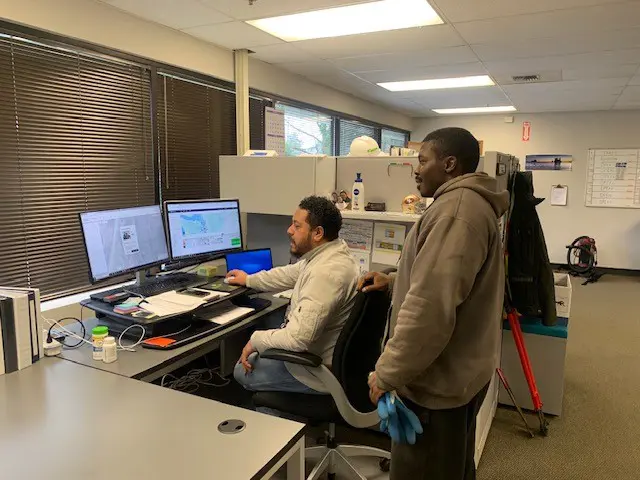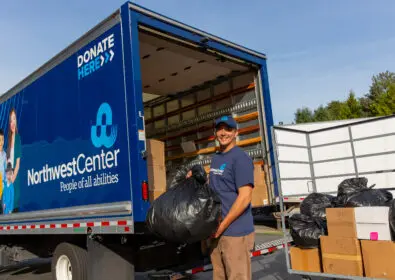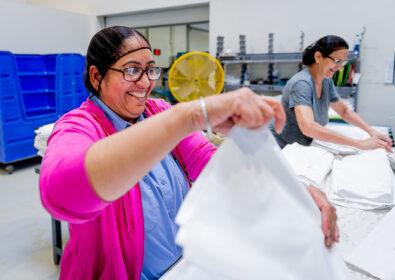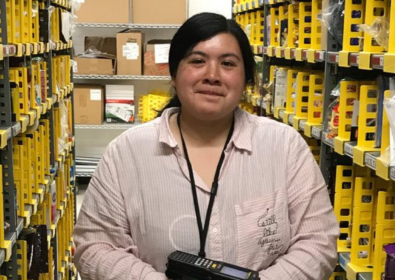The idea of a growth mindset is tossed around a lot in workplaces. At The Big Blue Truck, Tevin lives it every day.
Since graduating from Seattle’s Ingraham High School, Tevin has moved steadily ahead in his career. He started as a client of Northwest Center’s Employment Services Program at the Pacific Science Center, then joined the graveyard shift at The Big Blue Truck (BBT). Tevin quickly became a full-time employee and moved to the day shift.
Then he began driving those Big Blue Trucks.
“I want to see where I can take my opportunity and learning to another level,” Tevin says.
Tevin has dyslexia and thrives at work because he is able to apply his talent, skills, and the goal-focused drive of a competitive powerlifter at an inclusive business that recognizes all three. The Big Blue Truck is a Northwest Center Social Enterprise business, one that delivers high-quality service collecting donations of clothes and small household goods. The business employs people of all abilities as part of its inclusive business model.
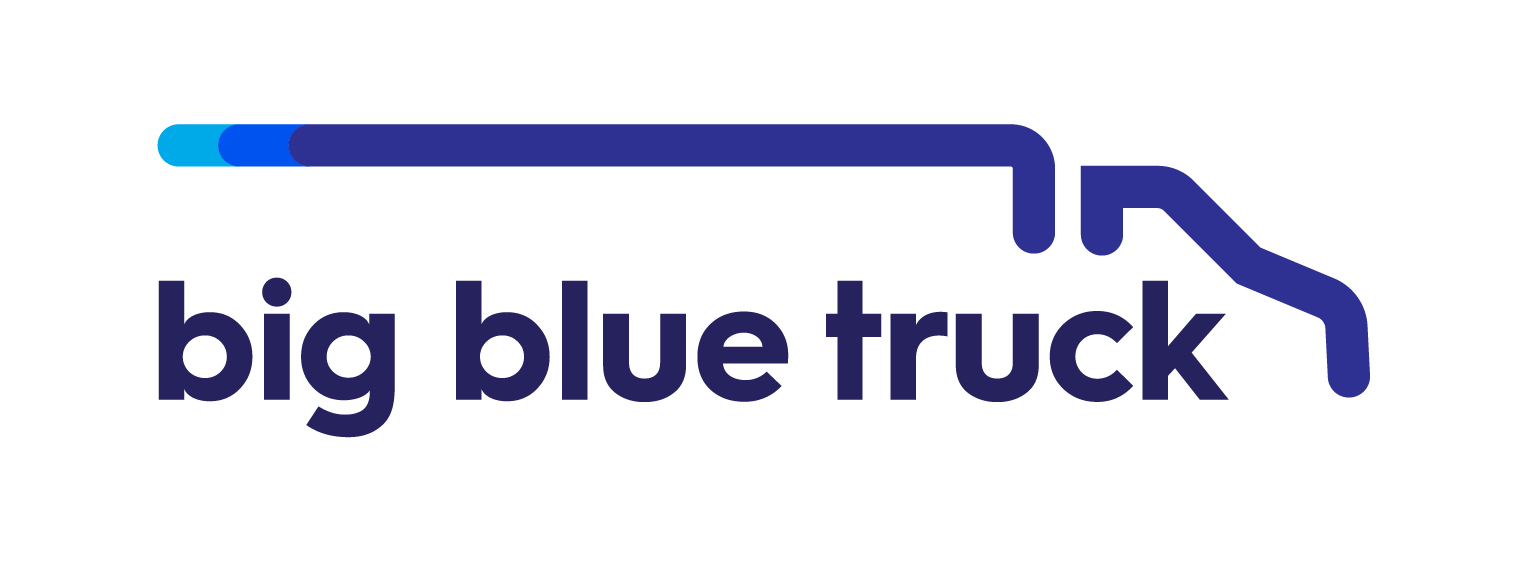
Building an Inclusive Workplace
The Big Blue Truck is a place where Northwest Center, which has worked for an inclusive world for more than half a century, lives one of its core beliefs: A workplace that benefits people with disabilities works for everyone.
“Each one of his growths has been an initiative of his,” Jacob, BBT’s Operations Manager, says. “What would it take to be a driver? He will beat us to the punch in growth potential.”
Every day, The Big Blue Truck proves that creating an inclusive workplace does not usually mean a lot of expensive and disruptive changes. It simply means a better run business. An inclusive workplace can boost a business’s bottom line by transforming work for the better, Nora Genster, head of Northwest Center’s Employment Transformation Collective, says.
“What works with Tevin I carry over to every other employee,” Tevin’s direct supervisor, Travis Klishak, says. “I would venture Tevin has changed the workplace more than the workplace has adjusted for him.”
After Tevin joined the BBT team, Jacob began holding two-to-five-minute check-ins, or “stretches,” with him each morning. What did he need to know about the upcoming workday? Those conversations were so productive, BBT began holding staff-wide “stretches” each morning, when the entire staff checks in on goals for the day.
“They don’t feel like a cog…They know which way we are heading,” Jacob says. “Laying business decisions at the forefront so people feel like they are part it.”
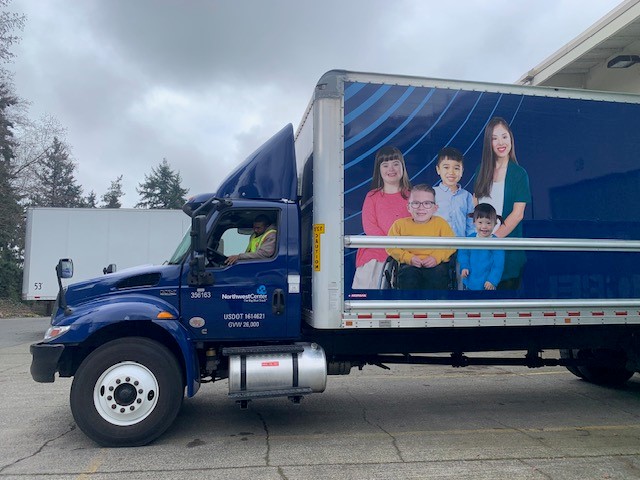
Tevin backing up a Big Blue Truck at SeaTac headquarters.
Raising the Standard
If you want to see the impact of an inclusive workplace, look inside a Big Blue Truck trailer.
Before Tevin joined the warehouse team, trailers were usually filled with 31,000 to 32,000 pounds of clothing and small household goods. Once Tevin joined the team those trucks were filled with more than 35,000 pounds of goods, and sometimes 40,000 pounds. He raised the bar.
“To even produce some of the numbers was unheard of in my first two years here,” Jacob Sao recalls. “He kind of helped changed the standard.”
The Benefits of Inclusion
Despite the clear benefits of an inclusive workplace, few businesses embrace those benefits. Most companies around the world – 90 percent – may say they prioritize diversity, but “only 4 (percent) of businesses are focused on making offerings inclusive of disability,” the World Bank reported in 2022.
“People with disabilities often lack access to employment,” according to the report. “The current global employment rate for disabled people is just half that of non-disabled people. People with disabilities who are employed often experience unequal hiring and promotion standards, unequal pay for equal work and occupational segregation.”
Closing the Gap
The good news is businesses are closing the gap.
Over the last five years alone, the percentage of people with disabilities in the workforce rose from 29 percent to 37 percent, Accenture stated in its 2023 report “The Disability Inclusion Imperative.”
And leading CEOs are working together to advance disability inclusion. The Valuable 500, for example, is “the largest global network of CEOs committed to disability inclusion,” according to the World Bank.
Good CEOs are known for their focus on the bottom line, and they are embracing an inclusive workplace because it improves that line. Companies that are leaders in certain disability criteria reported:
- 1.6 times higher revenue over five years compared to peers
- 2 times the economic profit
- 2.6 times higher net income (“The Disability Inclusion Imperative,” Accenture.)
There is a long way to go. Even as the percentage of workers with a disability rises, 76 percent of surveyed workers with disabilities did not fully disclose their disabilities to their employers, Accenture stated in its 2023 report.
Creating an Inclusive Workplace
Businesses interested in creating a more inclusive workplace for people with disabilities can start by checking out The Big Blue Truck.
Communication is a foundational element of The Big Blue Truck’s inclusive and productive workplace. Managers tailor training and communications to a staff member’s strengths – what a person needs to thrive in a role.
“How often can I frame work in a way you can understand it, so barriers don’t inhibit your ability to succeed?” Jacob says.
Ask questions. Then listen. What barriers is an employee facing at work? How can a business remove those barriers and give an employee back time to do the actual job? Workers with disabilities are often forced to spend a lot of time navigating inaccessible systems. This costs companies in lost productivity and revenue, and – just as important – it impacts employees’ abilities to do their jobs and can negatively affect their mental health, ETC’s Nora Genster points out.
“I would venture Tevin has changed the workplace more than the workplace has adjusted for him.”
And removing barriers, often referred to as accommodations, often costs businesses little or nothing. Those changes that do cost money typically return that investment and more.
In the U.S., nearly a quarter of the workforce could benefit from an accommodation at work. And more than half of the accommodations would cost nothing. Yet, only about half of these workers receive accommodations.
Next Steps
At The Big Blue Truck, Tevin continues to move up the ladder as the business builds an inclusive culture. Over the 2024 holiday season, Tevin stepped up to manage BBT’s Mukilteo Depot, a job that demanded a new set of management skills.
With his growth mindset, Tevin was soon managing the depot alone.
“Whatever is open, take that chance,” Tevin said.
It’s a lesson for CEOs and managers around the world.
“I wish everyone worked in the world where their potential, and their desire, and their want to, determined how far they went,” The Big Blue Truck’s Jacob Sao said.
To learn more about The Big Blue Truck, including how and where to donate, and its history, check out the website.
If you are interested in learning more about how to create and support an inclusive workplace please visit the Employment Transformation Collective, or reach the team at the Contacts page.
